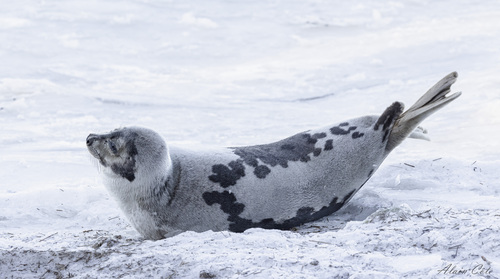
Harp Seal
The harp seal, Pagophilus groenlandicus, thrives in Arctic waters, famed for its distinctive harp-shaped markings and sociable demeanor. Relying on sea ice for breeding, these playful pinnipeds play a critical role in the marine ecosystem, showcasing resilience in harsh environments.
Length: 1.5 - 2.0 m
Size
Grey, Black, White
Color
5.5 years
Age of Sexual Maturity
10-12 days
Age of Weaning
Least Concern
Conservation Status
Increasing
Population Trend
Characteristics
Commonly known as the harp seal, Pagophilus groenlandicus is recognized for its striking black harp-shaped markings on its back and silvery-gray fur. It inhabits the icy waters of the North Atlantic and Arctic Oceans. These social mammals are known for their playful nature and rely on sea ice for breeding.
Distribution Range of the Harp Seal
Pagophilus groenlandicus, commonly known as the harp seal, is native to the North Atlantic and Arctic Oceans. Their geographical distribution primarily includes the waters surrounding Canada, Greenland, Norway, and Russia. The species is particularly abundant in regions such as the Gulf of St. Lawrence, the Greenland Sea, and the White Sea.
Harp Seal's Habitat
Environmental Conditions
Harp seals inhabit cold marine environments, typically characterized by icy waters and pack ice during certain times of the year. They depend on sea ice for breeding and molting. The climate in these regions is generally subarctic to polar, with temperatures often below freezing, especially during winter months.
Ecological Niche
Harp seals are marine mammals adapted to life in cold, icy environments. They are excellent swimmers and divers, feeding primarily on fish and invertebrates, such as capelin, herring, and krill. Their ability to thrive in icy waters is supported by their thick blubber and fur, which provide insulation. Harp seals play a significant role in the marine ecosystem as both predators and prey, with various adaptations allowing them to navigate and survive in their harsh native habitat.
Copyright @ Nature Style Limited. All Rights Reserved.
 English
English